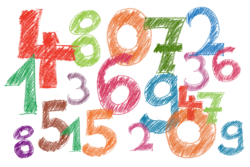 Which numbers are spelled out and which are written as numerals? It depends on the type of writing you are doing. Here are some basic rules for writing numbers:
Which numbers are spelled out and which are written as numerals? It depends on the type of writing you are doing. Here are some basic rules for writing numbers:
1.In scientific or technical writing, spell out numbers one through nine, and use numerals for numbers 10 and higher. However, in literary writing — or writing in the humanities — spell out numbers through ninety-nine. And remember that twenty-one through ninety-nine are hyphenated when they are two words.
2. In charts, figures, and tables, it is fine to use numerals for all your numbers. In fact, it is preferable and looks much better.
3. Never begin a sentence with a numeral. Write out the number or rewrite the sentence so the number doesn’t appear at the beginning.
- One hundred members of the band marched down the street.
- We watched as 100 members of the band marched down the street.
4. If you have a sentence with two numbers that refer to similar things, or the same thing, either write them both out or use numerals for both. It doesn’t matter what the numbers are.
- We counted 9 boys and 112 girls at the girls’ softball game.
- I made 6 dozen cookies and 150 cupcakes.
5. Spell out very large numbers instead of using a series of zeroes — even in a chart or table.
- The population of my city is nearly 2 million now OR
- The population of my city is nearly two million now.
6. Dimensions, sizes and exact temperatures should be expressed in numerals.
- The weather forecast calls for a high of 20 degrees tonight.
- She wears a size 10 dress.
7. Always use numerals along with a.m. or p.m.
- Let’s meet at 7:30 a.m. tomorrow.
8. With the word o’clock you can use either numerals or words.
- The meeting is at two o’clock.
- The meeting is at 2 o’clock.
9. Hyphenate fractions like two-thirds when spelling them out. Apply the same usage rules to fractions as other numbers.
10. Do not use firstly, secondly, and thirdly as transition words. Use first, second, and third.
—————————————————————————————————————————————————————————————-
Yay! Now available on Amazon, Kindle, and other online stores.
Come to the book launch at Copperfield’s Books in Petaluma, CA: Friday, March 16 at 7 p.m.
Yay! Now available on Kindle and other e-readers.





Of course, every rule — or, if you like, formulation — has exceptions. Regarding the use of numerals for time — with “a.m.” or “p.m.” — I remember a movie from circa 1970 called “Adam at Six A.M.” “Six” was invariably spelled out, both in newspaper reviews and in the title of the movie itself; I think it’d have looked wrong as a numeral!
Yes, there are always exceptions. Curious: Did they put the A.M. in small caps? Technically, a.m. should be in small caps, but rarely is. Not sure 6 would have looked weird; I guess it what you get used to. Thanks for bringing this up!
I agree with everyone else. this is a succinct post that covers it all. Good job!
Thanks so much. Thonie!
A great summary, Arlene. Better than great. (1) hundred-and-10 per scent) greater.
Ha! Thank you so much, Gordon!
Arlene, this is exactly what I was looking for—a nice synopsis of these number rules. Nicely done!
Thanks, Ruth!
Great! Thank you very much. This is what I`m trying to explain my students.
You are very welcome. I am happy it helped!
Good information for me. This was very readable with good examples and explanations. I look forward to learning more. Do you tutor. I’m sure I would benefit from private sessions. Thanks in advance. Sincerely.
I don’t tutor…… 🙂 I just correct your mistakes as you go along 🙂